2½-ton 6x6 truck
The 2 1⁄2-ton 6x6 truck was a class of medium trucks designed for the US Armed Forces. The basic cargo versions were designed to transport a 5,000 lb (2,300 kg) cargo load over all terrain in all weather. Widely used in World War II, the "deuce and a half" continued to be the US standard medium duty truck class after the war. Five different designs were standardized by the U.S., two were also standardized by Canada. One was built primarily for Lend-Lease export during World War II, and many others have been exported to smaller militaries. The US began replacing 6x6 trucks with the 4x4 Light Medium Tactical Vehicle (LMTV) in 1991.

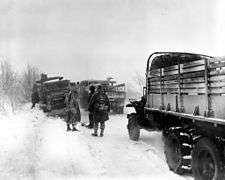
History
In 1940 the US Army set a requirement for a 6×6 truck with a 2 1⁄2-ton (2,268 kg) off-road payload. Dump, semi-tractor, tanker, and other bodies were also planned. This size truck could carry a full infantry squad, tow light artillery, and yet be built in large numbers on moving assembly lines.
Yellow Coach (a GM company), Studebaker, and International Harvester submitted designs, all three were accepted and in production by 1941. Yellow’s CCKW became the Army standard, International’s M-5-6 became Navy and Marine Corps standard, and Studebaker’s US6 was built for export to allied countries. A design by REO was not accepted.
In the late 1940s the military needed a new standard truck. Chrysler, GMC, REO, and Studebaker submitted designs. The REO design was standardized for all services as the M35, and continued standard until 1990. The GMC was classed as substitute standard M135 in the US but became standard in Canada.[1][2]
Designs
GMC CCKW

As the standard US Army design during World War II, over 560,000 were built, more than any other US vehicle except the "Jeep". By 1947 there were over 20 standardized bodies, and many more special modifications.
Production began at Yellow Coach’s Pontiac, Michigan truck plant in 1941 and at Chevrolet’s St. Louis plant in 1942. In 1943 Yellow was renamed G.M.C., leading to the popular nickname "Jimmy". Production ended in 1945.
Early trucks had GM’s standard closed cab, from July 1943 military open cabs, which were easier to build and lowered shipping height, were used. To conserve steel, later cargo bodies were built largely of wood. The C.O.E. AFKWX, 6x4 CCW, and amphibious DUKW were mechanically virtually identical and were built next to CCKWs in both plants.[3][4][5][6][7]
Studebaker US6

The US6 was very similar in layout to, and shared some components with, the CCKW. Studebaker built over 195,000 at their South Bend, Indiana plant between June 1941 and August 1945, REO built another 22,000 in 1944-1945. The majority were exported Lend-Lease to the Soviet Union.
Early trucks used a commercial style closed cab, in December 1942 an open military style cab entered production. The Soviet Union preferred the closed cabs for their extreme weather, so in March 1943 the open cabs were discontinued, after only about 10,000 were built.
The Studebakers were very successful in the Soviet Union, where they carried large loads on poor roads in extreme weather. They were so successful that they were closely copied as the ZiS/ZiL 151 and 157 family of trucks, built in the USSR until 1966 and in China until 1986.[3][8][9][10]
IHC M-5-6
The International design began production at Ft. Wayne, Indiana, in 1941. 500 M-5-6s and 3,000 M-5-6x4s, with a commercial K model cab, were complete by 1942, and were exported to the Soviet Union. The design then was upgraded, with a larger engine, tires, military open cab, and other improvements, and standardized as the M-5H-6 for the US Navy and Marines. The only 2 1⁄2-ton with locking differentials, it had excellent off-road performance. More than 30,000 of all models were built between 1941-1945.[3][4][11][12]
REO M35

The standard post-war 2 1⁄2-ton truck was manufactured by AM General, Bombardier (Canada), Curtis-Wright, Kaiser-Jeep, REO, Studebaker, and Studebaker-Packard from 1950 until the 1980s. The M35 has had the widest range of bodies of any US truck. The cab design itself became the military standard, also used by 5 and 10-ton trucks. First built with a gasoline engine, in 1964 the multi-fuel became standard. In 1991 existing M35s began to be upgraded with diesel engines and automatic transmissions. Canadian trucks had automatic transmissions as built.[3][13][14][15]
GMC M135
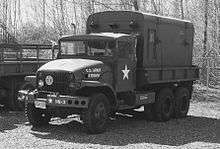
After the REO M35 was standardized GMC submitted a different design. An evolution of the CCKW, the GMC was classed as substitute standard M135 in the US but was widely used by the Canadian Army called the Deuce and a Half.
M135 was the only 2 1⁄2-ton truck designed with an automatic transmission. The transmission had 4 speeds and 2 ranges, with a 1-range transfer case.[3][4][16]
Bodies
Cab
All of the 1940 designs had commercial type closed cabs with minor modifications. Variants had an open passenger roof so a ring for a .50 caliber machine gun could be mounted, during World War II approximately one in four trucks had a ring. In 1942, to simplify production and reduce shipping height, all manufacturers began to use military style open cabs. Studebaker returned to closed cabs. The post-war M35 and M135 were designed with open cabs and half-doors. All military cabs could mount a machine gun ring. The M35 and M135 had removable hard tops available.[3][10][13][16][17]
Cargo Trucks
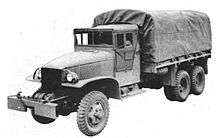


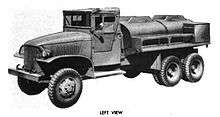

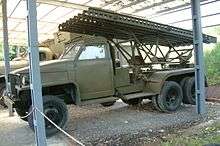
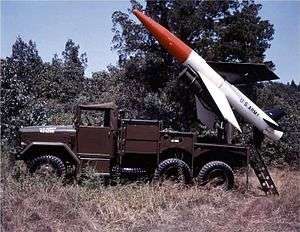
All series had a cargo model with a 12 ft (3.66 m) body on a long wheelbase. The 1940 designs had a 9 ft (2.74 m) prime mover type body on a short wheelbase, the M35 series had a 17 ft 5 in (5.31 m) body on an extra long wheelbase.
All models had removable sideboards and overhead bows for a tarpaulin over the cargo area. All except the extra long M36 had folding troop seats in the sideboards.
Late in World War II, to conserve steel, cargo bodies were made largely of wood, postwar the M35 and M135 series returned to steel.[3][10][13][16][17]
Dump Trucks
All series had dump trucks on a short wheelbase. The US6 also had side-dump trucks. The cab stone-shield could be removed on all to lower shipping height. They could be equipped with overhead bows, tarpaulin, and troop seats.[3][10][13][16][17]
Tractor Trucks
The M-6H-6, M211, and M35 series had a semi-tractor on a short wheelbase, the M35 series also had a long tractor. Neither GMC or Studebaker built a 6x6 tractor during World War II.
Semi-tractor/trailers have limited off-road performance, and are not rated for full off-road use. The M35 and M211 series fifth wheel load rating was 12,000 lb (5,400 kg) on road and 7,000 lb (3,200 kg) off road. A 36,000 lb (16,000 kg) trailer could be towed on road and a 17,000 lb (7,700 kg) one off.[3][10][13][16]
Tanker Trucks
All series had fuel and/or water tanker versions on long wheelbases. Capacities were 750 US gal (2,800 l) to 1,200 US gal (4,500 l) in 2 or 3 compartments, depending on the series and whether carrying gasoline or water. Most could be fitted with bows and a tarpaulin to camouflage themselves as common cargo trucks.[3][17][16]
Van Trucks
The CCKW, M35, and M135 had a 12 ft (3.66 m) van model on a long wheelbase. These could be equipped for many different roles. The M35 also had a 17 ft (5.18 m) model with slide out sections on both sides. "Expansible" vans are used for communication equipment.[3][16]
Rocket launchers
Two models have been used as rocket launchers. During World War II US6 chassis-cabs carried the impressive "Stalin's Organ" Katyusha rocket launchers. In 1959-1964 the M35 series M398 was the launcher for the unsuccessful Lacross guided missile.[3]
Notes
- ↑ Crismon (2001), pp. 356-362.
- ↑ Doyle (2003), pp. 105-160.
- 1 2 3 4 5 6 7 8 9 10 11 12 Doyle (2003).
- 1 2 3 Crismon (2001).
- ↑ Hyde (2014), pp. 203-207.
- ↑ TM 9-801 (1944), pp. 13-14, 35-40.
- ↑ Ware (2014), pp. 239-239.
- ↑ Ware (2014), p. 111, 181.
- ↑ Hyde (2014), pp. 65-67, 208-209.
- 1 2 3 4 5 TM 9-807 (1943).
- ↑ Hyde (2014), pp. 209.
- ↑ Ware (2014), p. 236.
- 1 2 3 4 5 TM 9-819 (1952).
- ↑ TM 9-2320-209-10-1 (1980).
- ↑ TM 9-2320-386-10 (1996).
- 1 2 3 4 5 6 7 TM 9-8024 (1955).
- 1 2 3 4 TM 9-801 (1944).
References
- Crismon, Fred W. (2001). Modern U.S. Military Vehicles. MBI Publishing. pp. 356–362. ISBN 0-7603-0526-9.
- Doyle, David (2003). Standard catalog of U.S. Military Vehicles. Kraus Publications. pp. 105–160. ISBN 0-87349-508-X.
- Hyde, Charles K. (2014). Images from the Arsenal of Democracy. Wayne State Univ. pp. 203–207. ISBN 978-0-8143-3982-4.
- Ware, Pat (2014). The Illustrated Guide to Military Vehicles. Hermes House. pp. 238–239. ISBN 978-1-78214-192-1.
- TM 9-801 Truck, 2 1⁄2-ton 6x6 GMC CCKW-352 & 353. US War Dept. 1944. pp. 13–14, 35–40. Retrieved 29 Oct 2016.
- TM 9-807 2 1⁄2 ton 6x6 Truck and 2 1⁄2 to 5-ton 6x4 Truck (Studebaker Models US6 and US6x4). US War Dept. 1943. Retrieved 29 Oct 2016.
- TM 9-819 2½ ton 6x6 Cargo truck M34 (and others). US Dept. of the Army. 1952. Retrieved 29 Oct 2016.
- TM 9-2320-209-10-1 Operation, Installation, and Reference Data Operator’s Level 2 1⁄2-ton, 6x6, M44A1 and M44A2 Series. US Dept. of the Army. 1980. Retrieved 29 Oct 2016.
- TM 9-2320-386-10 Operator’s manual for 2 1⁄2-ton, 6x6, M44A3 Series trucks (Diesel). US Dept. of the Army. 1996. Retrieved 29 Oct 2016.
- TM 9-8024 Operation and Organizational Maint. 2 1⁄2-ton 6x6 Cargo Trucks M135 and M211 (PDF). US Dept. of the Army. 1955. Retrieved 6 Mar 2016.